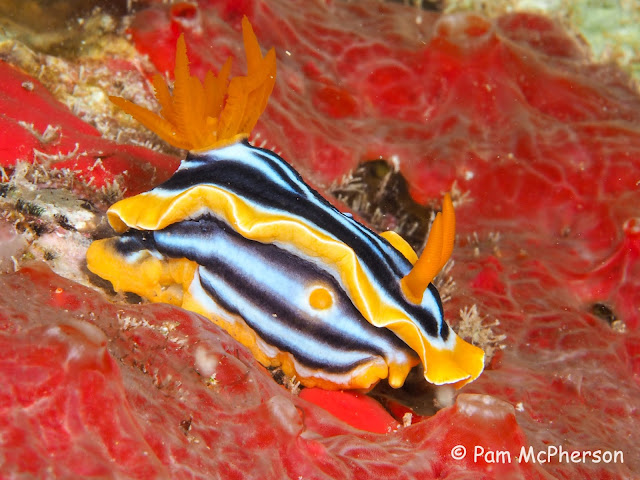This "bonus" week stared out a little slowly on the nudibranch front. In fact, I almost didn't compile a list at all, since the few nudis I saw were already on last week's list… and then a dive on the SS Thistlegorm came through and I accumulated 15 unique species!
There were only eight divers this week who were really cool.
We had quite an encounter with an Oceanic White Tip Shark.
When Adel did the briefing for the Shark and Yolanda Dive Site, he was honest with us that the day before, an Oceanic White Tip Shark attacked three snorkelers. People are not allowed to snorkel at this dive site, but this group did. The Egyptian snorkel guide suffered a bite to his middle. A Ukranian Mom/Son were also injured. Hers weren't bad, but the 10 year old son lost an arm and was seriously injured.
But Adel assured us that the shark probably wouldn't show up and even if it did, it wouldn't be interested in people on SCUBA. He told us how to stay safe: Look it directly in the eye, don't thrash or look injured and don't spend very long at the surface when getting in the zodiac.
The dive was fun and nothing showed up… but Adel found a pair of child's shorts that were completely ripped up and showed them to me underwater. The thought came to me that maybe Adel was playing a practical joke on us (David in particular).
Then four of us were at our safety stop: Adel, Amin, David and me. Then the exact shark that attacked the snorkelers showed up and acted erratically. It was swimming close to us, checking us out. It was swimming on the surface and even "tasted" the ladder of the zodiac.
This was no prank.
As it took a turn to swim away, I knew it was our chance to get into the zodiac. David went first and went up with his full kit still on… and then he got caught on something and had trouble ascending the ladder, so I messed with him and used my hand to bite the bootie on his foot. Then I took off my fins quickly and climbed up in my full gear. I have never gotten into the zodiac so fast!!!
I captured some crappy GoPro footage, but here is Adel and David's video footage, which is much better:
Official press release from the Egyptian government:
https://www.facebook.com/EGY.Environment/posts/2716301891942197
Dive Magazine UK:
http://divemagazine.co.uk/eco/9170-shark-seriously-injures-sharm-snorkellers
It was like a shark soap opera on the boat all week. Zoe had updates on what the government was saying and what others were saying on social media. It fluctuated from all three of the snorkelers died, to all of them survived, to the shark should be killed. Ugh.
Here is what I believe is true:
- The shorts were the kid's shorts. Adel sent a photo of them to the Egyptian government and the Mom confirmed it.
- All of the snorkelers lived. The child lost an arm and the guide had serious injuries to his middle region.
- The Egyptian Government closed all of Ras Mohammed region to both snorkeling and diving for at least a month. I am so happy I got to dive it last week and this week.
On a different topic, Josh made it into the video this week with a Chromodoris quadricolor crawling over him.
When I rebooked my flights, I didn't realize that my last dive might butt up into my "no fly" time. Gah! I chose to do my last dive, but I didn't stay that long since the wreck started at 80 feet deep. My dive computer cleared within an hour of the 4am flight time. Whew!
I made Iron Diver three weeks in a row.
Our final dinner out at Heaven where we celebrated Alex's birthday:
Here are the nudis I saw:
1 - Chromodoris quadricolor
Specific to Red Sea and Tanzania
2 - Chromodoris africana
3 - Unknown
I looked at this one many times wondering if this was a nudi or not. If you look closely, it seems there are rhinophores on the right and gills on the left.
Expert Marli Wakeling weighed in on this: Likely not a nudi, but a snail.
4 - Hexabranchus sanguineus
5 - Flabellina rubrolineata
Specific to Red Sea, Arabian Sea
6 - Tambja kava
It was so small and laying eggs!
7 - Phyllidiopsis sinaiensis
Specific to Northern Red Sea
Expert Marli Wakeling weighed in on this: Not P. sinaiensis; need to see the rhinophores to narrow it down.
Unfortunately, this is the best I was able to capture so it will have to remain a mystery.
8 - Chromodoris magnifica
Expert Marli Wakeling weighed in on this: Chromodoris quadricolor
Darn it, I thought this was a unique one.
9 - Phyllidiopsis krempfi
Expert Marli Wakeling weighed in on this: Not P. krempfi; probably P. zeylanica
That's also a new one, so that's good!
10 - Phyllidia schupporum
Specific to Northern Red Sea
We had quite a debate about this on the Facebook Group Nudibase!
I love it when there is some chatter on the ID.
11 - Phyllidia rueppelii
Specific to Red Sea
From Marli Wakeling: I would post on Nudibase and Nathalie Yonow will chime in. We've had some discussion about P. ruepelli and P. schupporum lately. The photo in NSSI2 of P. ruepelli is likely wrongly IDd.
12 - Halgerda sp. 7
Specific to Red Sea
13 - Phyllidiopsis dautzenbergi
Specific to Red Sea
14 - Phyllidia ocellata
From Helmut Debelius Red Sea Guide: This color form has been described as the distinct species Phyllidia undula but is now included in this highly variable, wide ranging species. However, this very distinct colour form is found only in the Red Sea and at the coasts around the Arabian penninsula.
15 - Pteraeolida semperi






















No comments:
Post a Comment